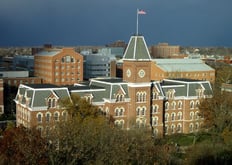We often hear about the dangers that human encroachment has on coral reefs, but far less often do we hear of ways the coral can survive. Though global warming continues to threaten the coral reefs of the world, researchers at The Ohio State University have discovered that some species of coral are actually doing a very good job of surviving, and that their rate of survival is directly proportional to their fat content.
Read MoreTags: Ohio State University, 2015, BioResearch Product Faire Event, Columbus, OH, OhStu
We’ve recently seen some compelling results when it comes to destroying brain tumors. A UCLA team blasted tumors with nanoparticles and a Washington University team shut down stem cells in the tumors to prevent them from regenerating. But what if we saw the tumors forming so far in advance that we didn’t need to blast them or worry about their regeneration? A breakthrough from Ohio State University proposes a way to forecast brain tumors long before their onset.
Read MoreTags: Ohio State University, 2015, BioResearch Product Faire Event, Columbus, OH, OhStu
Growing human organs outside of the body is more reality than science fiction these days. We have seen researchers reproduce a human heart from bicep muscle cells at the Mayo Clinic in Rochester and grow stomachs and intestines in the labs of the University of Cincinnati. Now The Ohio State University is taking on the challenge of recreating the human brain.
Tags: Ohio State University, 2015, BioResearch Product Faire Event, Columbus, OH, OhStu
 With the assistance of a recent $10 million contribution to Ohio State University, donors Stan and Joan Ross are helping to establish the Stanley D. and Joan H. Ross Center for Brain Health and Performance. Once open, this center will coincide with the Brain and Spine Hospital currently being constructed at the Ohio State University Wexner Medical Center that is slated to open in 2016. (Image courtesy of Nheyob via Wikimedia Commons).
With the assistance of a recent $10 million contribution to Ohio State University, donors Stan and Joan Ross are helping to establish the Stanley D. and Joan H. Ross Center for Brain Health and Performance. Once open, this center will coincide with the Brain and Spine Hospital currently being constructed at the Ohio State University Wexner Medical Center that is slated to open in 2016. (Image courtesy of Nheyob via Wikimedia Commons).
Tags: Midwest, Ohio State University, 2015, BioResearch Product Faire Event, Columbus, OH, OhStu, New research center, Wexner Medical Center, Brain Health and Performance
Tags: Ohio State University, 2015, BioResearch Product Faire Event, Columbus, OH, OhStu
The newest addition to the Ohio State University Campus - the new Chemical and Biomolecular Engineering and Chemistry Building - held its grand opening earlier this month, on April 10, 2015. Located at the heart of the science and engineering portion of campus, the new building greaty expands laboratory and research space.
Read MoreTags: Midwest, Ohio State University, 2015, BioResearch Product Faire Event, Columbus, OH, OhStu, new Building
In the past year, we have seen some excellent progress in the field of breast cancer. Researchers at the University of Texas found a way to reduce breast cancer recurrence, and five University of Cincinnati researchers won grants for their advances in the field. Now Ohio State University has earned its time in the spotlight with a new drug that reverses tumor growth.
Read MoreTags: Ohio State University, 2015, BioResearch Product Faire Event, Columbus, OH, OhStu
Though we often report on the miraculous effects of suppressing or expressing just one gene, very often changing a single gene has minimal impact. However, in some cases the combination of two genetic changes does something far more drastic than changing either gene individually. In a recent study published by The Ohio State University, a research team found two innocuous gene variants whose mutations work together to protect against heart attacks.
Read MoreTags: Ohio State University, 2015, BioResearch Product Faire Event, Columbus, OH, OhStu
Life science research has brought us the realization that one does not simply “age.” In the eyes of biotechnology researchers, the aging of the human body is a complicated, multifaceted process made up of several subprocesses. Some of these subprocesses can be delayed, stopped and even reversed. We saw one such example last month with a UCLA study on cell autophagy. Today, researchers from Ohio State University bring us another aspect of aging and show that it is reversible.
Read MoreTags: Ohio State University, Ohio, 2015
If a malicious bacterium seems particularly hardy in the face of current treatments, it’s probably only because we haven’t discovered its secret weakness. This seems to be the prevailing ideology at Ohio State University: earlier this month we saw how deactivating a single gene starves Salmonella and renders it essentially harmless. Now OSU researchers have pinpointed a protein in E. coli that, when inhibited, causes the bacteria to explode.
Tags: 2014, Midwest, Ohio State University, Ohio, BioResearch Product Faire Event, Columbus, OhStu

